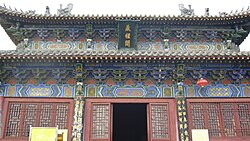Buddhist texts library
| Buddhist texts library | |||||||
|---|---|---|---|---|---|---|---|
 | |||||||
| Chinese name | |||||||
| Traditional Chinese | 蔵經閣 | ||||||
| Simplified Chinese | 藏经阁 | ||||||
| Literal meaning | The Buddhist Texts Library The Buddhist Sutras Library | ||||||
| |||||||
| Vietnamese name | |||||||
| Vietnamese alphabet | Tàng Kinh Các | ||||||
| Chữ Hán | 藏經閣 | ||||||
A Buddhist texts library (simplified Chinese: 藏经阁; traditional Chinese: 蔵經閣; pinyin: Cángjīnggé) is a large building in Chinese Buddhist temples which is built specially for storing The Chinese Buddhist Canon (大藏經).[1] It is encountered throughout East Asia, including in some Japanese Buddhist Kyōzōs (経蔵).[1] The Chinese Buddhist Canon is the total body of Buddhist literature deemed canonical and was called "all the sutras" (一切經) in the ancient time.[1] With four thousand kinds, it includes Āgama (經), Vinaya (律) and Abhidharma (論) texts.[1] Āgama are theories made by Buddha for disciples to practice, Vinaya are the rules formulated by Buddha for believers and Abhidharma is the collection of theories explanations by Buddha's disciples.[2][3]
A Buddhist texts library is generally two-storey buildings built at the highest point of the temple.[1] The upper storey is for storing sutras and the lower layer is the "Thousand Buddha Pavilion" (千佛閣).[1]
References
[edit]- ^ a b c d e f Zi Yan (2012-08-01). Famous Temples in China. Beijing: Time Publishing and Media Co., Ltd. pp. 48–50. ISBN 978-7-5461-3146-7.
- ^ Wei Ran (2012-06-01). Buddhist Buildings. Beijing: China Architecture & Building Press. ISBN 9787112142880.
- ^ Han Xin (2006-04-01). Well-Known Temples of China. Shanghai: The Eastern Publishing Co. Ltd. ISBN 7506024772.
Further reading
[edit]- Wang Guixiang (2016-06-17). 《中国汉传佛教建筑史——佛寺的建造、分布与寺院格局、建筑类型及其变迁》 [The History of Chinese Buddhist Temples] (in Chinese). Beijing: Tsinghua University Press. ISBN 9787302427056.
- Zhang Yuhuan (2014-06-01). 《图解中国佛教建筑、寺院系列》 (in Chinese). Beijing: Contemporary China Publishing House. ISBN 9787515401188.
